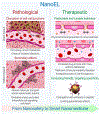Nanotoxicology and Nanomedicine: The Yin and Yang of Nano-Bio Interactions for the New Decade
- PMID: 36937379
- PMCID: PMC10018814
- DOI: 10.1016/j.nantod.2021.101184
Nanotoxicology and Nanomedicine: The Yin and Yang of Nano-Bio Interactions for the New Decade
Abstract
Nanotoxicology and nanomedicine are two sub-disciplines of nanotechnology focusing on the phenomena, mechanisms, and engineering at the nano-bio interface. For the better part of the past three decades, these two disciplines have been largely developing independently of each other. Yet recent breakthroughs in microbiome research and the current COVID-19 pandemic demonstrate that holistic approaches are crucial for solving grand challenges in global health. Here we show the Yin and Yang relationship between the two fields by highlighting their shared goals of making safer nanomaterials, improved cellular and organism models, as well as advanced methodologies. We focus on the transferable knowledge between the two fields as nanotoxicological research is moving from pristine to functional nanomaterials, while inorganic nanomaterials - the main subjects of nanotoxicology - have become an emerging source for the development of nanomedicines. We call for a close partnership between the two fields in the new decade, to harness the full potential of nanotechnology for benefiting human health and environmental safety.
Keywords: NanoEL; coronavirus; microbiome; nanomedicine; nanotoxicology; protein corona.
Conflict of interest statement
Declaration of interests The authors declare that they have no known competing financial interests or personal relationships that could have appeared to influence the work reported in this paper.
Figures





References
-
- Kahru A, Ivask A, Acc. Chem. Res 46 (2013) 823–833. - PubMed
-
- Kagan VE, Bayir H, Shvedova AA, Nanomedicine 1 (2005) 313–316. - PubMed
-
- European Commission http://ec.europa.eu/environment/chemicals/nanotech/reach-clp/index_en.htm. (2018).
-
- Kreuter J, Int. J. Pharm 331 (2007) 1–10. - PubMed
Grants and funding
LinkOut - more resources
Full Text Sources
Miscellaneous
